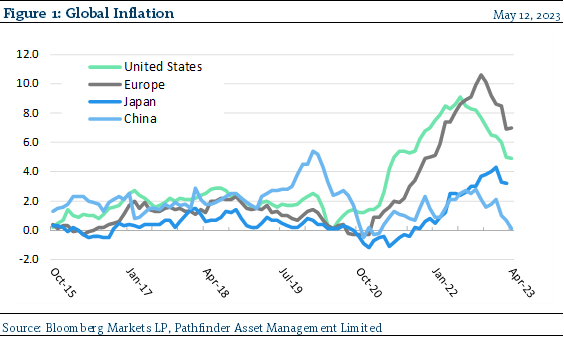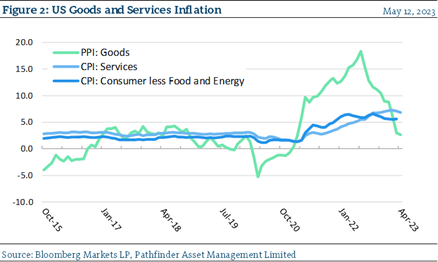Thoughts on Inflation
Two weeks ago, we identified three areas of focus that we will be discussing this spring. The interplay between these three major economic forces will impact all investors. They are somewhat related, and dependent on each other, so our discussion will sometimes seem circular, as the topics lead into one another. Three topics are:
- The trajectory of the economy and the potential for slow-down / recession.
- The Job market, its impact on corporate profitability (negative) and consumer spending (positive).
- Inflation and how the US Fed and financial markets interpret and react to data.
With respect to Item 3, during our daily investment call, we review economic data from the major world economies. During our review recently, we have seen inflation moderate. It is somewhat geography dependent but does look like prices have decreased for a number of sectors of the global economy. Figure 1 presents inflation rates from around the world. As you can see, inflation remains elevated in most countries after peaking during the pandemic. It does also appear that the structural deflation/low inflation that pained Europe and Japan for decades has been broken. While inflation has come down globally for the most part, it remains too high for most central bankers around the world.

Figure 2 presents goods and services inflation. The supply chain disruptions that drove scarcity of goods have essentially been fixed, and many industries are now dealing with over-stocked inventories. Near-shoring will remain a structural theme but as you can see, services and consumer are high and sticky.

This means that, as we noted last week, it is hard to see the US going into recession with a strong employment market but given that the FOMC has stated it will hold its tight monetary policy until its preferred measure of inflation drops essentially in half… something will eventually have to give. A recession will probably come from breaking structural inflation with higher rates, and that means essentially creating unemployment.
National Instrument 31-103 requires registered firms to disclose information that a reasonable investor would expect to know, including any material conflicts with the firm or its representatives. Doug Johnson and/or Pathfinder Asset Management Limited are an insider of companies periodically mentioned in this report. Please visit www.paml.ca for full disclosures.
Changes in Leverage. We are increasing the asset ceiling to 2.0 times the market value of equity for Pathfinder International Fund and Pathfinder Real Fund to be consistent with Pathfinder Partners’ Fund and Pathfinder Resource Fund
*All returns are time weighted and net of investment management fees. Returns from the Pathfinder Partners’ Fund and Partners’ Real Return Plus Fund are presented based on the masters series of each fund. The Pathfinder Core: Equity Portfolio and The Pathfinder Core: High Income Portfolio are live accounts. These are actual accounts owned by the Pathfinder Chairman (Equity) and client (High Income) which contain no legacy positions, cash flows or other Pathfinder investment mandates or products. Monthly inception dates for each fund and portfolio are as follows: Pathfinder Core: Equity Portfolio (January 2011), Pathfinder Core: High Income Portfolio (October 2012) Partners’ Fund (April 2011), Partners’ Real Return Plus Fund (April, 2013), and Partners’ Core Plus Fund (November 2014).
Pathfinder Asset Management Limited (PAML) and its affiliates may collectively beneficially own in excess of 10% of one or more classes of the issued and outstanding equity securities mentioned in this newsletter. This publication is intended only to convey information. It is not to be construed as an investment guide or as an offer or solicitation of an offer to buy or sell any of the securities mentioned in it. The author has taken all usual and reasonable precautions to determine that the information contained in this publication has been obtained from sources believed to be reliable and that the procedures used to summarize and analyze such information are based on approved practices and principles in the investment industry. However, the market forces underlying investment value are subject to sudden and dramatic changes and data availability varies from one moment to the next. Consequently, neither the author nor PAML can make any warranty as to the accuracy or completeness of information, analysis or views contained in this publication or their usefulness or suitability in any particular circumstance. You should not undertake any investment or portfolio assessment or other transaction on the basis of this publication, but should first consult your portfolio manager, who can assess all relevant particulars of any proposed investment or transaction. PAML and the author accept no liability of any kind whatsoever or any damages or losses incurred by you as a result of reliance upon or use of this publication.